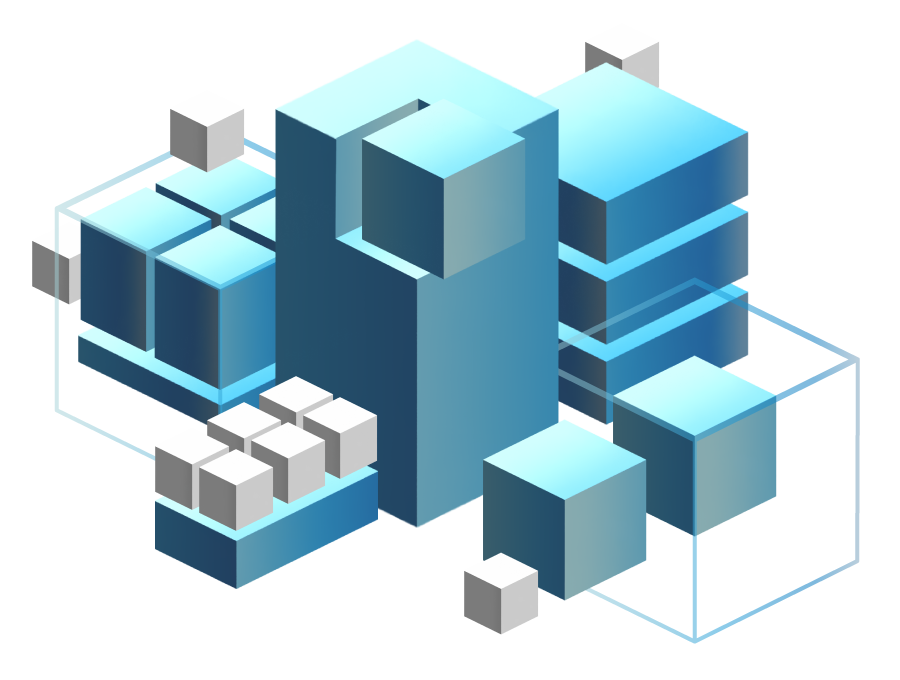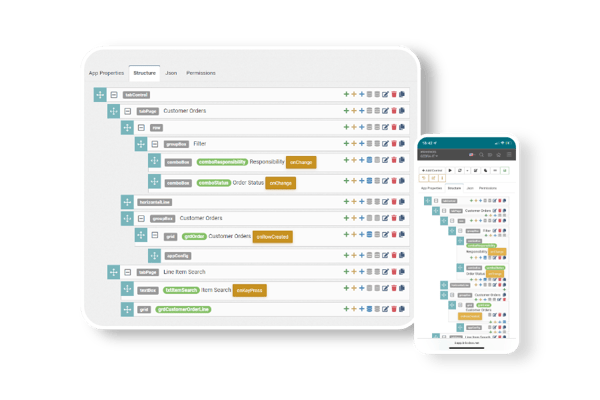Enterprise applications with brixxbox
brixxbox Low-Code-ERP Platform & more
Enterprise applications with brixxbox
brixxbox Low-Code-ERP Platform: Take your development to a new level and realize business applications with brixxbox and Low-Code! From now on, you can design ERP, merchandise management, and CRM systems 100% individually - exactly as you or your customers need it. Thanks to the graphical modular principle of brixxbox, you can implement new developments as well as updates much faster than with classically programmed software. At the same time, the low-code approach guarantees a low entry barrier to enterprise-level development: basic knowledge of JavaScript and SQL is enough!
Applications without compromise
What works with brixxbox Low-Code?
Use Case: Quite everything! Thanks to its unique modular principle, brixxbox is able to map almost all business processes in their entirety. What is difficult or impossible to implement in standard software and is expensive and time-consuming with classic special programming, you can realize with brixxbox in no time at all.
Thanks to the graphical user interface, many things can be done via drag-and-drop: Distinct programming skills in complex languages such as C++ or Java are not necessary. The full potential of brixxbox unfolds with basic knowledge of JavaScript and SQL. A low hurdle compared to the possibilities: With brixxbox, the software adapts to your requirements - not the other way around.

Quality without sacrifice
Enterprise applications with brixxbox:
This speaks for itself!
Compared to the alternatives, application development with brixxbox stands out due to various aspects - for example with regard to the flexibility of data models. Where standard software prescribes a database with tables that can only be expanded or adapted with immense effort, the following applies here: The entire data structure can be built individually with brixxbox. In doing so, the construction kit copes with all conceivable data models and types: no matter whether master and basic data, transaction data or satellite data. The creation of dependencies between the data is also easy and flexible with brixxbox. What else speaks for the development of enterprise applications with brixxbox, you can read in the following:
Security
No chance for risks: brixxbox and applications created with it are always up-to-date - there are no outdated versions! In addition, your data is backed up multiple times and is encrypted behind a firewall on Microsoft servers. Extensive rights management ensures that each individual user only sees and edits what they should be able to see and edit. In addition, you can track all changes made, both in the construction kit and in the finished application, and undo them if you wish.
Indidviduality
100% process coverage without special programming and subsystems: Your brixxbox applications can always do exactly what you need. Various interfaces thereby enable the data exchange between your and other applications.
Topicality
With brixxbox you rely on the most modern, future-oriented technologies. In addition, both the brixxbox construction kit itself and your applications are always up to date: As soon as your latest version is ready, you can release it directly to all users for immediate use.
Scalability
brixxbox applications grow with your needs: Whether your workflows become more complex, your data volumes increase, or you want to add thousands of users - or all at once.
Speed
Thanks to the graphical user interface and modular principle, development time is reduced enormously: new requirements are implemented quickly and updates are made available in record time.
Mobility
Device and location-independent use thanks to the cloud: Use your applications when and where you want. No matter whether it's a low-code ERP, enterprise resource planning or CRM system. An on-premise solution can also be implemented if desired.
Internationality
brixxbox automatically translates your applications into different languages and is equipped for country-specific features. At the same time, you always have the option to fine-tune it yourself!
Experience low-code for yourself:
This is how easy it is to develop applications with low-code.
Free online presentation with consultation - book now!
Business without ifs and buts
Application examples in the enterprise sector
With brixxbox, you can develop pretty much any type of enterprise application based on low-code: ERP systems, solutions for production planning and control, and much more. Do you have the processes and data models to be mapped in mind? Then the foundation for your customized business application is already laid! The following application examples illustrate how you can benefit - in addition to the above-mentioned advantages - from the implementation with brixxbox.
Enterprise resource planning (ERP) systems are used to plan, control and manage operational resources such as capital, personnel and materials. The more accurately an ERP system maps corporate processes, the better workflows can be optimized and consequently both time and costs can be reduced. Since standard software has to work in many different companies, it reaches its limits quite quickly when it comes to individual process coverage.
The situation is different when developing with brixxbox and low-code: ERP systems based on brixxbox are capable of completely mapping almost all business processes. Depending on the scope, adjustments can be made in minutes - without having to hire a programmer or IT specialist. This means that appropriately trained employees from specialist departments can also participate in the (further) development of the ERP system, which leads to even better adaptation to the company. This in turn ensures greater acceptance and satisfaction among employees.
Although software solutions for merchandise management and enterprise resource planning (ERP) are often used synonymously, strictly speaking, merchandise management is a subarea of ERP - with a focus on tasks such as procurement, requirements determination, logistics, warehouse management and transport. Consequently, a good merchandise management system ensures that those responsible always have an overview of the movement of goods within the company. However, the transitions between merchandise management systems and ERP software are now fluid. A circumstance that you can take into account when implementing with brixxbox!
Whether the management of multiple warehouses, a sophisticated warehouse management, a complicated returns process, the organization of multiple clients or a company-specific language use: brixxbox offers you a simple and flexible way to map your business processes easily and flexibly with just one system. And in such a way that you can adapt the processes in your company cleanly and scalably in the future. And if you want to turn your pure merchandise management system into a full-blown ERP system at some point, that's also possible!
Customer relationship management, or CRM for short, pursues the continuous improvement of business relationships. A CRM system consequently supports companies in maintaining relationships with customers, optimizing processes and increasing profitability. Accordingly, the core task of a CRM system is the clear structuring of all customer-related data and information managed in it. This can be, for example, e-mails, telephone calls and profiles from social networks. In addition, notes and comments can be stored for each contact.
CRM systems are used across departments: For example, it can be used by sales for inquiry and quote management, while it is used in marketing to analyze customer behavior. Again, the service department uses it differently: for example, for complaints and complaint management as well as service deployment planning. With brixxbox, you can create CRM systems that precisely meet the individual application purpose of each employee. For example, with overview pages and user interfaces optimized specifically for sales, marketing and service. This way, everyone sees exactly the information they need - in the optimal arrangement and sequence.
